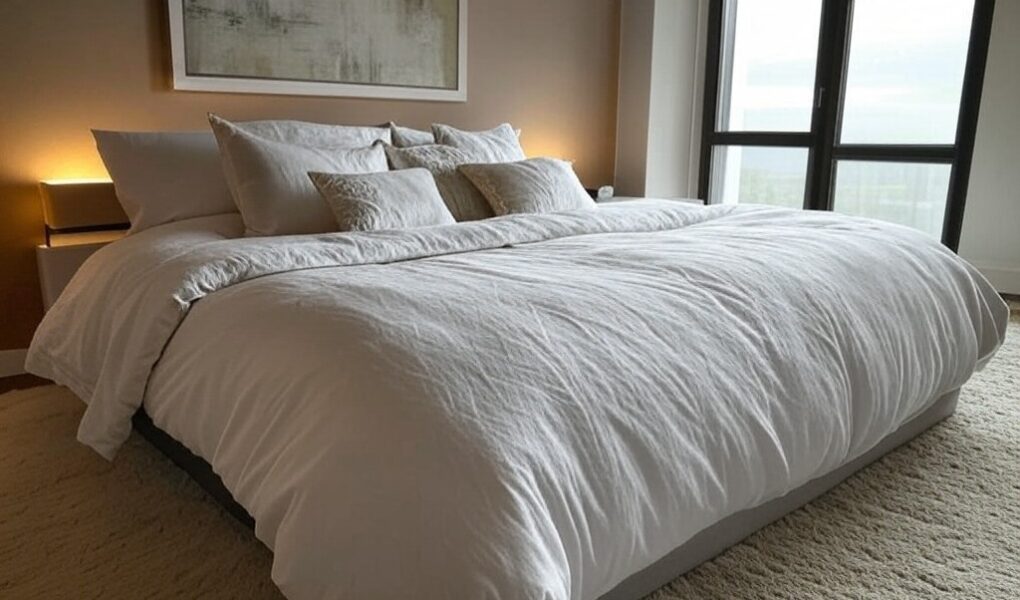Choosing the right bed size can significantly impact your sleep quality and overall comfort. King-size beds have gained popularity for their spacious sleeping area, but are they always the best choice? A king-size bed offers 16 inches more width than a queen, providing ample room for couples who value personal space.
King-size beds excel in master bedrooms and can comfortably accommodate children or pets who like to snuggle. They’re ideal for those who toss and turn or prefer to spread out while sleeping. However, these larger beds come with considerations. They require more floor space, which may be challenging in smaller rooms. Additionally, king-size bedding and accessories tend to be more expensive than their queen-size counterparts.
For couples seeking extra room or individuals who enjoy luxurious sleeping arrangements, it’s worth taking the time to discover king size bed options; while the extra space is appealing, it’s essential to weigh factors such as room size, budget, and personal preferences before making a decision.
Key Takeaways
●King-size beds offer more sleeping space but require larger rooms and costlier accessories.
●The choice between king and queen depends on individual sleep needs and bedroom dimensions.
●Consider factors like budget, room size, and personal comfort when selecting a mattress size.
Evaluating Bed Sizes
Choosing the right bed size involves considering dimensions, room space, and personal lifestyle factors. These elements play crucial roles in determining comfort and functionality.
Comparative Dimensions
King-size mattresses measure 76 inches wide by 80 inches long, offering 16 inches more width than queen-size mattresses at 60 inches by 80 inches. This extra space can be significant for couples or those who prefer more sleeping room. California king mattresses provide even more length at 84 inches, but reduce width to 72 inches. This option suits taller individuals or rooms with a longer, narrower layout.
A mattress size chart can help visualize these differences:
Mattress Size Width Length
Queen 60″ 80″
King 76″ 80″
California King 72″ 84″
Space Considerations
Room size heavily influences bed choice. A king-size bed requires a larger bedroom to maintain proper circulation and accommodate other furniture.
For optimal comfort, a king-size bed needs a room at least 12 feet by 12 feet. Queen-size beds fit well in rooms 10 feet by 10 feet or larger. Smaller bedrooms may feel cramped with a king-size bed, limiting space for dressers, nightstands, or walking areas. Queen-size beds often provide a better balance in average-sized rooms.
Fitting the Sleeper’s Lifestyle
Personal preferences and sleeping habits are key factors in bed size selection. Couples often prefer king-size beds for extra space, reducing sleep disturbances from partner movement. Solo sleepers might find a queen-size bed sufficiently spacious while leaving more room for other bedroom activities. However, some individuals enjoy the luxury of a king-size bed even when sleeping alone. Those who frequently host guests or have children who occasionally sleep in their bed may appreciate the extra space of a king-size mattress. Active sleepers or those who use their bed for reading or working might also benefit from the additional width.
Analyzing Bed Quality and Cost
King-size beds offer more space but come with higher price tags. Quality, comfort, and cost vary significantly between different mattress types and brands.
Choosing the Right Mattress Type
King-size mattresses come in various types, each with distinct qualities. Innerspring mattresses provide traditional bounce and support. Hybrid mattresses combine coils with foam layers for balanced comfort. Memory foam conforms to body shape, while latex offers natural resilience. When selecting a mattress, consider your sleep preferences and any physical needs. Side sleepers may prefer softer surfaces, while back or stomach sleepers often need firmer support. Test different mattresses in-store if possible. Many online retailers offer generous trial periods, allowing you to return the mattress if unsatisfied.
Assessing Motion Transfer for Shared Sleeping
Motion transfer is crucial for couples sharing a king-size bed. It refers to how much movement on one side of the bed affects the other side. Memory foam and latex generally excel at minimizing motion transfer. Hybrid mattresses with pocketed coils also perform well. Traditional innerspring mattresses typically have more motion transfer. To test motion transfer, lie on the bed while your partner moves around. If you feel minimal disturbance, the mattress has good motion isolation. Some mattresses use special technologies to further reduce motion transfer, like gel-infused foams or advanced coil systems.
Understanding Pricing and Value
King-size mattresses cost more than smaller sizes due to increased materials and manufacturing complexity. Prices can range from $500 to over $3,000, depending on quality and brand.
High-quality king mattresses often fall in the $1,500 to $3,000 range. Budget options exist but may lack the durability or comfort features of pricier models.
Consider long-term value when assessing cost. A well-made mattress can last 7-10 years, making the annual cost more reasonable. Watch for mattress sales, especially around holidays. Many retailers offer significant discounts during these periods. Don’t forget to factor in the cost of a new bed frame, bedding, and potentially a larger bedroom set when upgrading to a king-size bed.
Conclusion
King-size beds offer spacious comfort for couples and families. They provide ample room to stretch out and can enhance sleep quality. However, king beds require more space and come with higher costs for the mattress and accessories. Carefully weigh the pros and cons against your specific needs, budget, and bedroom size before deciding if a king-size bed is right for you.

